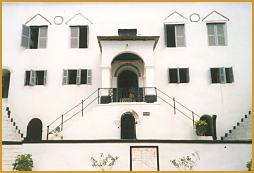ASHANTI TRADITIONAL BUILDINGS:
Anyone with an interest in African history has
heard of the Ashanti. They have been a powerful force in Ghana's
history. When the British "brought civilization" to Ghana
they approached from the sea and easily converted the people until
they reached the Ashanti where fierce warriors resisted colonization
for 70 years. This fighting destroyed many of the traditional
buildings in Kumasi, the capital of the Ashanti Region. As the city
was rebuilt, the uniquely decorated buildings were replaced by ones
built with cement blocks without the input of craftspeople whose
carvings and attention to architectural detail gave life to the
original buildings.
The traditional design consists of four
buildings surrounding a courtyard. The buildings are low,
constructed of mud plastered onto timber framework and are given
height by the addition of tall thatched roofs. Painted white, their
most distinctive feature is the elaborate geometric and sometimes
animal designs carved in bas-relief. As with everything else in
Ghanaian culture, the designs have meanings that have been handed
down through generations.
UNESCO with the help of the French Embassy in
Ghana and a few companies doing business in Ghana have added the
Ashanti Traditional Buildings to the list of World Heritage Sites
and have begun the work of restoring the remains of these buildings.
The few traditional buildings that remained intact are all shrines
to powerful deities. They are in villages near Kumasi. Not being in
the capital probably saved them from being destroyed, but what war
didn't erode, nature has.
Aba Tours recently took some tourists to visit
the shrine at Besease which is located a 10 minute drive from Kumasi
going toward Accra. From the outside you see a plain mud wall, but
as soon as you enter the courtyard you are in another century. For
an entrance fee of approximately $4.00 you are given a tour, a brief
history of the shrine (which is also recorded on plaques attached to
the courtyard walls) and the opportunity to take photographs. Near
the end of the tour our guide reached into the bushes and threw what
appeared to be rocks at our feet. When the rocks began to move, we
realized that these were turtles. Our guide explained that they were
enjoyed by the fetish priestess and therefore allowed to live there.
The priestess was not in the shrine, but as custom required, we left
a few coins near the door to her room. Although the shrines are
still considered powerful and spiritual by the Ashanti, many of the
priests and priestesses are elderly people, so besides being
neglected by nature the shrines also fall into disuse when the
leader is not replaced.
The Ghana Museums and Monument Board maintain
the 10 remaining traditional examples of early architecture, so even
if in the future they are not active shrines they will at least be
preserved as a memorial to a great Ashanti Empire.
SLAVE CASTLES:
Driving a few hours South of Kumasi you enter
the Central Region, home of another World Heritage Site. The
building is large, white and sits impressively next to the Atlantic
Ocean. Cape Coast is a picturesque fishing village and home to an
infamous slave castle.
 Cape Coast Castle was built by the British in
1665. Originally it was a small fort built by the Swedes and went
through ownership by Danes, Dutch and the local people, eventually
becoming the headquarters for the British Administration. Because so
many countries came to benefit from the riches of "The Gold
Coast" there were many forts in the country, but most of them
are in disrepair with the exception of a few such as the
Christainberg Castle in Accra which is now the seat of the Ghana
Government.
Cape Coast Castle was built by the British in
1665. Originally it was a small fort built by the Swedes and went
through ownership by Danes, Dutch and the local people, eventually
becoming the headquarters for the British Administration. Because so
many countries came to benefit from the riches of "The Gold
Coast" there were many forts in the country, but most of them
are in disrepair with the exception of a few such as the
Christainberg Castle in Accra which is now the seat of the Ghana
Government.
Cape Coast Castle, Elmina Castle in a
neighboring village and Fort St. Jargo which is on a hill facing
Elmina Castle were given the status of World Heritage Monuments by
UNESCO in 1979.
Perhaps the most visited tourist attraction in
Ghana, Cape Coast Castle is well maintained. Your entrance fee of
$2.00 (less for Ghanaians) entitles you to watch a brief video
covering the culture and history of Ghana, to visit a small museum,
to go on a tour led by a local volunteer and to revisit the tragic
drama of the slave trade. You are led into underground dungeons and
to the DOOR OF NO RETURN. This small opening led from the dungeon to
the sea where slaves were put into boats and taken away from their
land. The slaves were marched from the North and brought to a large
room in the castle where they were sorted according to age and sex
and sold or traded for guns.
There is much discussion now among scholars
about who sold the slaves to the Europeans. History shows that it
was fellow Africans and the discussion centers around whether they
knew what fate awaited the captives.
There is no way to visit Cape Coast Castle
without being overcome with sadness, but it is a necessary stop for
visitors. I can't imagine being in Ghana without experiencing this
important part of history.
Recently a DOOR OF RETURN has been added. This
signifies the return of the slaves descendents to Ghana to
acknowledge the history of their ancestors and each year Ghana
celebrates Emancipation Day which welcomes the people from the
Diaspora back to their homeland.